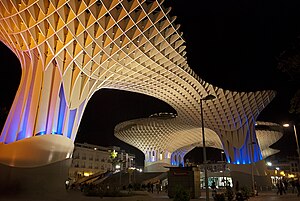Metropol Parasol
| Metropol Parasol | |
|---|---|
 |
|
| General information | |
| Location | Seville, Spain |
| Construction started | 2005 |
| Completed | 2011 |
| Management | Sacyr Vallehermoso |
| Design and construction | |
| Architect | Jürgen Mayer H. |
| Main contractor | Sacyr Vallehermoso |
Coordinates: 37°23′35.71″N 5°59′30.77″W / 37.3932528°N 5.9918806°W
Metropol Parasol is a wooden structure located at La Encarnación square, in the old quarter of Seville, Spain. It was designed by the German architect Jürgen Mayer and completed in April 2011. It has dimensions of 150 by 70 metres (490 by 230 ft) and an approximate height of 26 metres (85 ft) and claims to be the largest wooden structure in the world. Its appearance, location, delays and cost overruns in construction resulted in much public controversy. The building is popularly known as Las Setas de la Encarnación (Incarnation's mushrooms).
The structure consists of six parasols in the form of giant mushrooms ("Las setas" in Spanish), whose design is inspired by the vaults of the Cathedral of Seville and the ficus trees in the nearby Plaza de Cristo de Burgos. Metropol Parasol is organized in four levels. The underground level (Level 0) houses the Antiquarium, where Roman and Moorish remains discovered on site are displayed in a museum. Level 1 (street level) is the Central Market. The roof of Level 1 is the surface of the open-air public plaza, shaded by the wooden parasols above and designed for public events. Levels 2 and 3 are the two stages of the panoramic terraces (including a restaurant), offering one of the best views of the city centre.
Since the 19th century, a market was located in the plaza, housed in a market building. The building was partially torn down in 1948 in accordance with plans for urban renewal. The market itself remained however, until 1973, when the rest of the dilapidated building was finally torn down. The land remained dormant until 1990, when the city decided to construct underground parking with space for a market on top. However, in the midst of construction, ruins dating to Roman and Andalusian eras were discovered, and construction was frozen after an expenditure of 14 million euros. In 2004, the city decided to attempt to develop the area again, and opened an international competition to solicit bids.
...
Wikipedia
